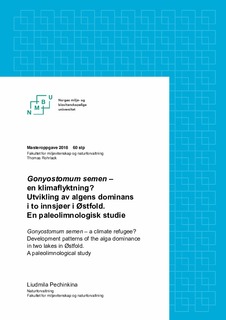| dc.contributor.advisor | Rohrlack, Thomas | |
| dc.contributor.advisor | Riise, Gunnhild | |
| dc.contributor.advisor | Haaland, Ståle | |
| dc.contributor.author | Pechinkina, Liudmila | |
| dc.coverage.spatial | Norway, Østfold | nb_NO |
| dc.date.accessioned | 2018-10-09T09:10:11Z | |
| dc.date.available | 2018-10-09T09:10:11Z | |
| dc.date.issued | 2018 | |
| dc.identifier.uri | http://hdl.handle.net/11250/2567046 | |
| dc.description.abstract | Organismer tilpasses de miljøforholdene (abiotiske og biotiske faktorer) de lever under. Dette innebærer at en populasjons utbredelse og størrelse blir begrenset av disse faktorene. En art med gode tilpasninger har bedre ressursutnyttelse og kan bli dominerende over andre arter i samme leveområde. Endringer i miljøforhold kan imidlertid favorisere en annen art, noe som kan føre til et dominansskifte.
Formålet med denne studien var å studere utvikling av mikroalgen Gonyostomum semen sin dominans i innsjøene Gjølsjøen og Bøvika og faktorer som favoriserte algen. G. semen karakteriseres som en fremmed art og har stort potensial til å dominere fytoplanktonsamfunnet under gunstige forhold. Algen antas å ha spredt seg til norske innsjøer fra Sverige som følge av nylig invasjon forårsaket av klimaendringer. I studien ble en sedimentsøyle fra hver innsjø datert ved hjelp av 137Cs og analysert for andel tørr romvekt, glødetap og pigmenter. De observerte variasjonene ble satt i sammenheng med utviklingen i nedbørfeltene, og resultatene av statistisk analyse ble diskutert utfra prosesser i nedbørfeltene og respons i innsjøene. | nb_NO |
| dc.description.abstract | Organisms adapt to the environment (i.e. abiotic and biotic factors) they inhabit. It means that distribution and abundance of a population is limited by these factors. A species with better adaptations uses available resources in a more efficient way and may become dominant over the other species living in the same habitat. Changes in the environment may however favour another species, and a dominance shift may take place.
The aim of the study was to investigate dominance patterns of the microalga Gonyostomum semen in the lakes Gjølsjøen and Bøvika as well as factors favouring the alga. G. semen is considered an introduced species with a high potential to dominate the phytoplankton community under favourable conditions. The alga is assumed to have dispersed to lakes in Norway from Sweden as a result of a recent invasion due to climate changes. A sediment core from each lake was dated by 137Cs, and dry bulk density, loss on ignition and pigment analysis were performed in the study. The observed variations were coupled with changes in the catchments, and the results of the statistical analysis were discussed from the point of view of processes in the catchments and responses in the lakes. | nb_NO |
| dc.language.iso | nob | nb_NO |
| dc.publisher | Norwegian University of Life Sciences, Ås | nb_NO |
| dc.rights | Attribution-NonCommercial-NoDerivatives 4.0 Internasjonal | * |
| dc.rights.uri | http://creativecommons.org/licenses/by-nc-nd/4.0/deed.no | * |
| dc.subject | Gonyostomum semen | nb_NO |
| dc.subject | Paleolimnologi | nb_NO |
| dc.subject | Fytoplankton | nb_NO |
| dc.subject | Klimaendringer | nb_NO |
| dc.title | Gonyostomum semen : en klimaflyktning? : utvikling av algens dominans i to innsjøer i Østfold : en paleolimnologisk studie | nb_NO |
| dc.title.alternative | Gonyostomum semen : a climate refugee? : development patterns of the alga dominance in two lakes in Østfold : a paleolimnological study | nb_NO |
| dc.type | Master thesis | nb_NO |
| dc.description.localcode | M-NF | nb_NO |

